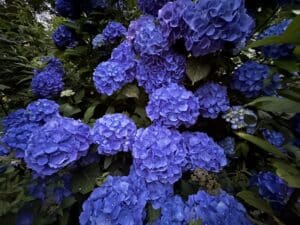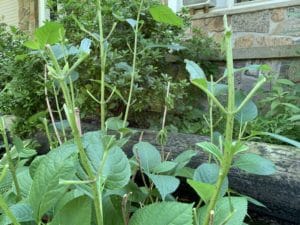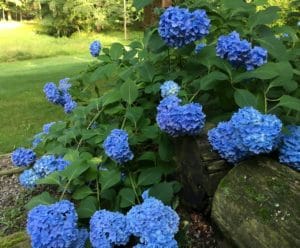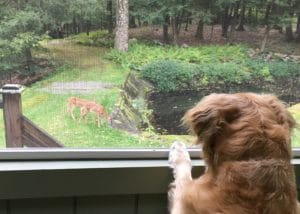Hello, fellow lovers of all things green,

Hydrangeas blooms have been bountiful this year!
Hydrangeas blooms have been bountiful this year in the Northeast due to the mild and wet winter without the normal cycle of freezing and thawing that damages buds. Mine are so heavily laden that they are flopping, blocking access to the front door. It’s a good thing folks use the back one. It exposed the dry canes in the center of the plant to remove. I’ve been breaking them off as I walk by, and Jolee enjoys snagging them to start a chase.
Now that the flowers are fading, I have a dilemma—how to lighten the load to regain access without losing next year’s blooms. It brings to mind a story about when deer pruned the hydrangea.
Deer devastation is Nature’s way of Pruning.
Five years ago, I woke to the swath of Bigleaf hydrangeas mowed down despite spraying using Deer Out, a natural go-to I’ve used for years. The damage brought weepy eyes, which seems silly in hindsight. “No point in crying over spilled milk,” one of Mom’s many idioms often shared. I never liked milk anyway.
They are the same hydrangeas Curt mistakenly pruned close to the ground a few years prior. He confused them with the Butterfly Bush that I asked him to cut back, as they benefit from rejuvenation pruning in early spring. After two summers with no flowers, our old-wooded hydrangeas rebounded to be profuse bloomers. Their recovery and colorful display are why I’ve grown so attached.
Speaking of hydrangea, I heard from a longtime friend living in Cliffside Park, NJ, near the George Washington Bridge. Deer weren’t a dilemma when I lived there years ago, but they are now. “My hydrangea didn’t bloom this year or last. I think it might be due to when I pruned them. When is the right time?” It depends on the variety.
When to Prune Hydrangea depends on the variety.
Most folks have the Bigleaf variety (Hydrangea macrophylla) or my favorite, Oakleaf Hydrangea (H. quercifolia), which bloom on old wood. So, if you are pruning to manage size, it should be soon after the flowers fade but before August 1st to encourage blooms next year. Panicle and Smooth hydrangeas (H. paniculate and arborescent) bloom on new wood. You can prune new wood bloomers before the flower buds form in late winter when the plant is still dormant.
The two most popular Bigleaf hydrangeas are Mopheads and Lacecaps. Rosemary’s is a Lacecap, which is okay to deadhead to the second pair of leaves when the flowers fade. But the flowers on the Mopheads are best left standing to protect new buds. They’re lovely to admire dry, especially when frosted with snow.
Rotating Deer Sprays Helps.
I was grateful that the day Bambi chomped the hydrangea, she spared the Hosta that sat beside it. I resprayed everything diligently. But the next day, I found the big burley ‘Sum and Substance’ Hosta munched to the stalks.
It’s time to put into practice what I preach. To rotate sprays as deer can grow accustomed. I gave Deer Off a try. The putrescent egg smell was a tad nauseating compared to the clove oil scent of my tried and true. But once it dried, it wasn’t bad.
Late that afternoon, a doe meandered in the woods, sunbeams gleaming on her rust-colored fur. Her white tail was whisking away flies. Behind her, two youngsters were frolicking as cute as can be.
“Hello there,” the momma looks up. “Quit eating my stuff, please. I’m asking nicely.” Compassion overcame me as I watched the beautiful family, and I understood their need for nourishment.
A newer Bigleaf Hydrangea called Endless Summer blooms on old and new wood. However, they can also suffer from winter bud damage, earning them a nickname—Endless Disappointment. But indeed, there’s no point in crying over spilled milk.
So, back to solving this year’s flopping hydrangea dilemma.

Jolee sat vigil while I pruned the fading hydrangea flowers and dry canes.
I’ll cut back enough fading blooms to get a bounce back of the branches to gain access to the walkway. That way, most of next year’s buds will remain protected for next year’s bounty. Seems logical, right?
Besides, I’ve been around the block on accidental pruning recoveries. That’s one thing about life: whenever we make mistakes, something more beautiful can emerge from them.
Garden Dilemmas? AskMaryStone@gmail.com and your favorite Podcast App.
There’s more to the story in the Garden Dilemma’s Podcast (@10 soothing minutes):
Link to Curt’s good intentions: Spring Garden Honey-Dos





